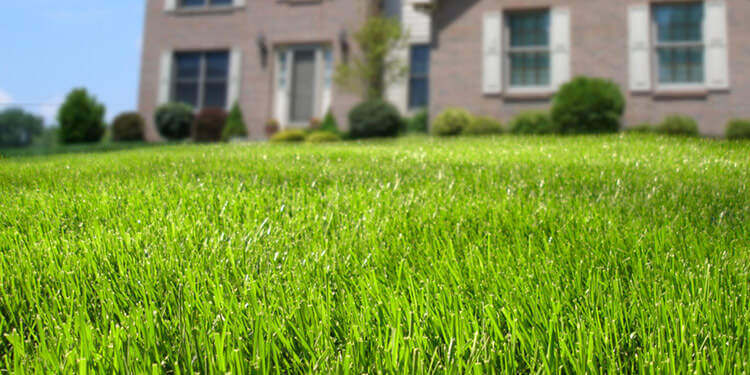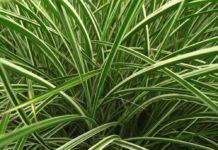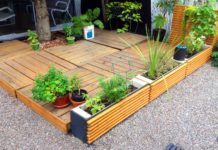By taking a few easy steps, you can end up with the greenest, healthiest lawn on your block. Here’s what to do!
1. Aerate your lawn. If you’re like most people, your lawn is the highest use area of your landscaping, especially if you have kids or pets. This means that over time the soil beneath your grass can become very compacted. Even the weekly chore of mowing your lawn can cause soil compaction. Compacted soil results in problems with air circulation, water drainage, and nutrient absorption. Additionally, beneficial soil organisms such as earth worms can’t establish in hard, compacted soil. If you want to really green up your grass and make your turf healthier and more beautiful, you should regularly aerate your lawn. Lawn aeration simply means punching holes throughout your lawn to about 3 inches deep. With regular lawn aeration, you can help give your grass a proper medium to grow in, which loose soil and better air circulation. You grass will also make better use of water and nutrients. Additionally, micro-organisms will establish themselves in your soil and help break down any thatch that builds up. There are several different ways to aerate your lawn, either by renting a large aerating machine or by using a simple handheld aerating tool. For most homeowners with small to medium sized lawns, a handheld aerating tool will do the trick. You should aerate your lawn about once a year.
2. Water your lawn deeply and less often. Turning your sprinkler on for just a few minutes a few times a week really won’t do much to help your lawn. For a healthier lawn, learn to water your grass deeply and less often. If you water infrequently and deeply, the roots of your grass will start to grow deeper down into the soil. This helps your grass stay green during periods of drought or extremely hot weather. Experts recommend that you water your grass with 1 inch of water, once a week. This amount of course can vary depending on your local weather conditions, soil type, grass species, etc. How do you know if you’re watering your plants with 1 inch of water? You can use this simple test. Place a series of shallow containers throughout your lawn and turn your sprinklers on. Keep watering until you measure 1 inch of water in the majority of the containers. This simple test will also help you determine if your sprinklers are watering your grass evenly. If the depth of the water in the containers varies widely, this may explain patches of drier grass in your yard. In this case you’ll need to adjust your sprinkler heads. It’s also important that you don’t over-water your grass. You’ll know when it’s time to water again when the first 3-4 inches of soil are dry to the touch. Use an electronic soil tester to test the soil moisture, or use a trowel or a screwdriver to open the soil and feel it with your finger. To help your grass retain even more water, you can use water absorbing polymers (water crystals). These water absorbing gel products, such as Greensense Solid Water, can help reduce the number of times you water your lawn by up to 50 percent. Remember, the best time to water your grass is the early morning and when there is no wind. This will help reduce problems with evaporation. Here is more information on how much to water your grass.
3. Use natural lawn fertilizers. Why use natural fertilizers instead of synthetic lawn fertilizers? Because they are better for your grass, the environment, and they are proven to work better than synthetics! A recent study by Austin’s Watershed Protection and Development Review Department, with the collaboration of Texas A&M, showed that organic and natural lawn fertilizers actually produce greener lawns than synthetics. Moreover, natural fertilizers are healthier for your family and for the environment! There are a number of natural lawn fertilizers to choose from. You can browse our selection here.
4. “Grass-cycle” your grass clippings. Grass-cycling involves letting your lawn reuse the grass clippings created by mowing. The great thing about grass-cycling is that it’s easy! You simply leave your grass clippings on the lawn instead of throwing them away. Why would you want to do this? Because it’s been proven that grass clippings will quickly decompose and return needed nutrients to the soil. The grass clippings also act as a natural mulch, helping your grass to retain water. Grass-cycling is a way not only to improve your lawn, it will also help you save time taking care of it! Other benefits of grass cycling include: improved soil texture, reduced need for fertilizers, saved time when you mow, and reduced waste that goes to the landfill. While you can convert most lawnmowers for grass-cycling, your best bet in to invest in a reel mower. Reel mowers are quiet, effective, easy to use, and most reel mowers leave the grass where it should be, on your lawn! If you just can’t stand the sight of grass clippings on your yard, another option is to compost them. Invest in a simple compost bin and use the compost in your lawn and garden.
5. Cut your grass correctly and to the recommended cutting height. Knowing what height to cut your grass is an important way to get your grass to grow healthy and strong. Setting your lawnmower to the highest or lowest setting is not necessarily the best thing for your grass. In fact, different grass species have different needs in terms of grass cutting height. Check out this guide to grass cutting height. Additionally, you should keep the blades on your lawnmower nice and sharp so that it cuts your grass effectively. Also, consider buying a reel mower, which actually cuts the grass like scissors rather than tearing it like traditional rotary lawnmowers. This makes for healthier grass in general. Read this guide to reel mowers for more information on the benefits of reel mowers and how to select one for your needs.
6. Compost your kitchen and garden waste for greener grass. As mentioned above, composting your grass clippings is a great way reduce waste and help your garden and lawn grow. Additionally, you can compost other waste from the garden and even from your kitchen. Adding compost to your soil is one of the best ways to green up your grass and all your garden plants. Compost has a number of other benefits, including:
- – Compost improves water drainage in clay and sandy soils.
- – Compost creates a slow release of plant nutrients and stimulates root growth.
- – Compost helps reduce problems with soil-borne plant diseases and garden pests.
- – Compost prevents erosion of precious topsoil.
- – Compost recycles yard and kitchen wastes instead of sending it to the landfill.
- – Compost balances the pH levels of most soils.
- – Compost attracts beneficial insects, worms, and other organisms
Composting is easy and rewarding. Read more about composting at the Compost Instructions web site.
7. Use corn gluten meal as a natural herbicide and lawn fertilizer. Corn gluten meal is used most frequently as a natural preemergent herbicide for turf grass and organic crops. However, it has the added benefit of fertilizing your soil. Corn Gluten Meal is a totally natural byproduct of the wet-milling process for corn (Zea mays L.). It will help control annual weeds in your lawn and will keep your grass fertilized. If you want to learn more about this great organic gardening product, please visit Dr. Nick Christians’ University of Iowa Corn Gluten research page.
8. Use Mycor Root Builder to improve your soil. Mycorrhizal fungi are beneficial soil organisms that provide a sort of secondary root system for your garden plants and grass. They attach themselves to the roots and help plants and grass make better use of water and organic nutrients in the soil. With a Mycorrhizal fungi root builder, you can get mycorrhizal fungi to work more efficiently. GreenSense Mycor Root Builder is an excellent product that contains Endomycorrhiza, Ectomycorrhiza, Scleroderma, Kelp, Zeolite, and liquid Humate. It will work great on all the plants you grow, not just your turf grass. Like these eight easy steps? Don’t forget to bookmark them!










